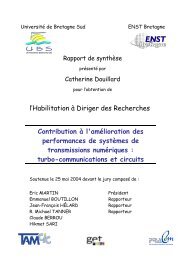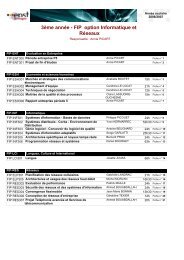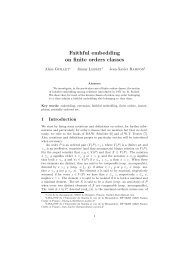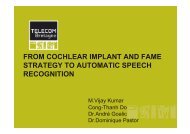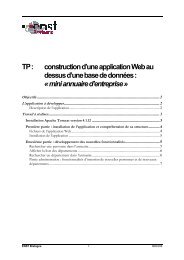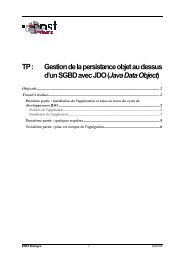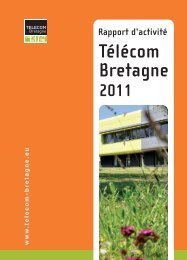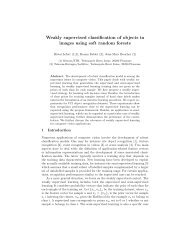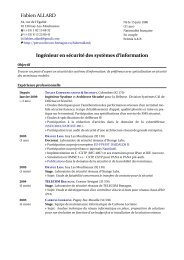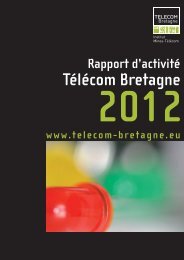researResearch - Télécom Bretagne
researResearch - Télécom Bretagne
researResearch - Télécom Bretagne
Create successful ePaper yourself
Turn your PDF publications into a flip-book with our unique Google optimized e-Paper software.
esearc<br />
<strong>researResearch</strong><br />
46<br />
Projects associated with<br />
the PERDYN platform:<br />
Two model optical access networks, in GEPON<br />
and GPON technologies respectively, were set up<br />
and evaluated. Working in collaboration with the<br />
Computer Science Department of Telecom<br />
<strong>Bretagne</strong> to analyse the traffic in these networks<br />
and after detailed characterisations of the<br />
existing prototype, an analysis of the solutions<br />
enabling integration of an OSNR in-band<br />
measure of the WDM canals was undertaken and<br />
early experimental results were obtained.<br />
Launch of the CapilR platform:<br />
The need for digital irrigation via the numerous<br />
access points has led to the creation of a new<br />
speciality: network fringe engineering. The<br />
emergence of new skills and services will lead to<br />
the creation of a synergy of different<br />
technological domains and their integration into<br />
a global vision of the network. This new<br />
development will lead to the selection of<br />
technologies that are adapted to the different<br />
field configurations and services, providing<br />
companies with the capacity to exploit existing<br />
infrastructure in order to deliver new forms of<br />
content and services to the end user. In France,<br />
today, such integrated skills are lacking. Our<br />
mission is to optimise the exploitation of existing<br />
infrastructures (e.g. bus, Metro, taxi, etc) in order<br />
to offer new services. This constitutes an original<br />
and coherent offer, integrating, as it does, optical<br />
technologies and radio frequencies, for the<br />
deployment of mobile networks in high-density<br />
environments. Depending on the needs, this will<br />
bring expertise, engineering advice, as well as an<br />
evaluation of the technologies proposed by<br />
selected equipment suppliers. This initiative is<br />
being pursued in close collaboration with the<br />
Microwaves Department of Telecom <strong>Bretagne</strong><br />
and the RESO laboratory of the ENIB.<br />
Thoughts on the issue of optical<br />
distribution within the home<br />
network:<br />
Optical fibres, being the backbone of<br />
telecommunications transport networks, have<br />
been incorporated into the access network in<br />
order to propose broadband solutions (100<br />
Mbit/s) to subscribers in urban areas. For<br />
domestic use, infra-red transmission is a<br />
classical solution to enable audio-video devices,<br />
mobile phones or portable computers to<br />
intercommunicate. It remains limited, however,<br />
to modest coverage and data rates (a few<br />
hundreds of kbits/s). Faced with the growing<br />
need for high speed data rates and considering<br />
the existing “radio” solutions which are subject<br />
to constraints in terms of power and spectral<br />
resources, optical transmission in indoor free<br />
space areas (IFSO) is envisaged for the medium<br />
term. It offers significant advantages: increased<br />
broadband transmission rates in theory, natural<br />
connectivity to an optical access network, no<br />
spectral rules and no interference from or with<br />
other domestic devices. The IFSO propagation<br />
modes can be classified into two types, namely,<br />
direct view and diffuse mode. At an intuitive level,<br />
the diffuse mode maximises receiver mobility<br />
and connection reliability, but the significant<br />
losses encountered necessitate high-powered<br />
transmission levels, since the maximum canal<br />
rate is limited by the reception of multiple paths.<br />
In contrast, the LOS mode provides higher data<br />
rates (several tens of Gbit/s) but requires precise<br />
alignment to and tracking of the transmitter in<br />
comparison to the receiver, as mobility is<br />
disturbed by the presence of obstacles. The<br />
challenge to be met, therefore, is the following:<br />
maximise the signal-to-noise ratio at reception<br />
while respecting eye-safety standards and, at the<br />
same time, developing a domestic multiple<br />
access topology which ensures connectivity,<br />
mobility and high broadband rates between<br />
users. In this context, we have been studying LOS<br />
optical connection systems based on dynamic<br />
deflectors enabling optimised tracking and<br />
visibility.<br />
To build flexible optical home networks,<br />
interconnecting the different access points<br />
(optical micro-cells) with short to mid-range<br />
(from 5 to 100m) polymer optical fibre (POF)<br />
sections is envisaged and which, potentially,<br />
would reduce the global energy cost of the<br />
system. This initiative is being developed in<br />
collaboration with the Signals and<br />
Communications Department of Telecom<br />
<strong>Bretagne</strong>.



